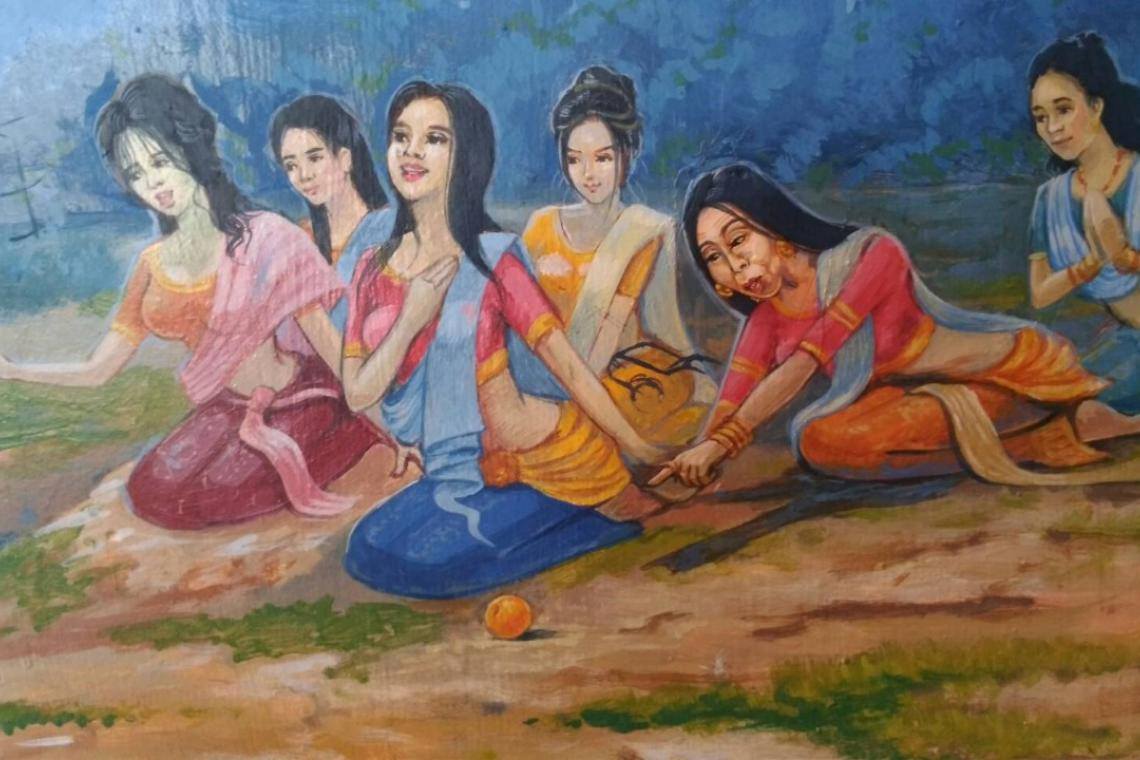Mural paintings of Mae Sitang Buathong, Prawit Wongsuwan and Prayut Chan-o-cha have become a controversy after the National Office of Buddhism and Tewan Liptapallop, Minister attached to the Prime Minister’s Office, declared that the paintings are inappropriate and should be erased. Tewan also ordered the National Office of Buddhism to uncover any paintings with hidden political messages in temples across the country.

The painting of Sitang Buatong, depicted her in a red shirt and pointing at an orange
Artist Jarunnapat Kaewum was commissioned by the abbot of Wat Nong Tao, Uthai Thani Province, to paint the story of the Buddha. While Jarunnapat was painting the scene where the Buddha descends from Tavatimsa heaven to preach his teaching to beings from 3 worlds, heaven, the earth, and hell, she drew Mae Sitang, a transgender who started the popular catchphrase “orange, stop! it stopped by itself.” The motivation behind this illustration is her personal liking of Mae Sitang and the fact that she wishes to portray a once-popular transgender net idol for future generations. “Mae Sitang is my first inspiration. We should praise a gender non-conforming individual who has contributed to today’s society. We should respect each one of them for guiding the way for all LGBTQ to follow in their footsteps,” said the artist.
In regard to the catchphrase, the painter intentionally drew her hand pointing at an orange, a depiction which is viewed by the National Office of Buddhism as offensive. This is because the act of pointing a finger at someone is rude and disrespectful to the Buddha in Thai culture. The painter then was forced to change the painting of Mae Sitang’s hand.
In addition to the portrait of Mae Sitang, the portrayal of faces which look like those of Prime Minister Gen Prayut Chan-o-cha and Deputy Prime Minister Prawit Wongsuwan are shown on another wall of the same temple. In this narrative, Prayut and Prawit represent some of the many temptations created by the evil Mara to obstruct the enlightenment of the Buddha. These paintings were removed immediately after they were considered irrelevant and disrespectful by officials without permission.
“It’s an outrageous act. It’s a great insult to artists, art and culture. It disrespects the people. Thai people are too considerate of civil servants when they are, in fact, supposed to serve the people […] They use their own standards to make decisions for society and define social ethics, which is wrong,” said Wara Chanmanee, a Thai researcher/scholar on the Channel 3 programme Hone-Krasae.
In general, murals in Thai temples portray events in the story of the Buddha, religious beliefs, kings, the Ramayana, and vignettes of people’s way of life in certain eras. Earlier murals in Thailand depict different things compared to modern murals.
According to Janio from the website Painaidii, there exist murals that show the lives of people in the 21st century which contradict traditional mural paintings. For example, there are pictures of people using iPhones or headphones, pictures of cartoon characters, or angry birds. Traditional murals (un)surprisingly depict the sex life of Thai people which now is usually a taboo topic in Thai society. It is a convention for painters to draw small satirical cameos on the wall. However, the picture of Mae Sitang was condemned by the National Office of Buddhism for having nothing to do with religious beliefs which are held to be sacred elements for people to revere.
The way the regime acted toward art minimized the freedom the artists used to have. If the work they produce conveys any political message or holds any satirical message about the regime, it must be censored or scrutinized before publicized. In other words, their creativity is much more restricted compared to when freedom of expression was still allowed in our society.
The reaction of the bureaucracy and the Minister seems to be an arbitrary form of political and moral censorship and poses for the Thai people the question of what is appropriate for mural paintings. If other paintings which are unrelated to the Buddha are left undisturbed, why are the paintings of Mae Sitang, Prayut and Prawit (tiny when compared to the image of the Buddha on the same wall) condemned and removed?
Prachatai English is an independent, non-profit news outlet committed to covering underreported issues in Thailand, especially about democratization and human rights, despite pressure from the authorities. Your support will ensure that we stay a professional media source and be able to meet the challenges and deliver in-depth reporting.
• Simple steps to support Prachatai English
1. Bank transfer to account “โครงการหนังสือพิมพ์อินเทอร์เน็ต ประชาไท” or “Prachatai Online Newspaper” 091-0-21689-4, Krungthai Bank
2. Or, Transfer money via Paypal, to e-mail address: [email protected], please leave a comment on the transaction as “For Prachatai English”
